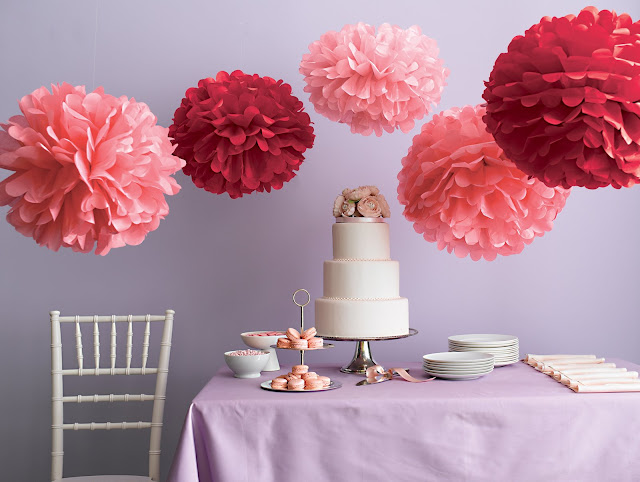Outdoor rooms have become something of a 'must-have' for homeowners who love their backyards. They are places of hidden refuge amid the more public zones of the outdoor spaces, tucked behind hedges, gates, or fences, or contained within a series of ceiling-less walls.
Since I do not have a yard, I now find myself pining for one of those outdoor rooms to escape to, especially with the weather warming up and the leaves popping out of every branch on every tree. Below I've compiled a series of some of my favourite outdoor rooms - ones I can only access by sight and imagination, but nonetheless alluring.
 Outdoor rooms do not have to be elaborate. This one above is charming and simple, contained within a wall of vines and potted plants. Designating a 'room' outdoors requires only a few simple elements:
Outdoor rooms do not have to be elaborate. This one above is charming and simple, contained within a wall of vines and potted plants. Designating a 'room' outdoors requires only a few simple elements:- A well-defined zone made more prominent by a differing groundcover or separated from the rest of the outdoor spaces by hedges, steps, pathways, fences or walls. It should be a destination.
- A function: a dining area, a sitting area, a reading area or an activity area. The 'room' should serve a purpose.
- Furniture: be it a dining table or a series of outdoor seats, the room needs its fixtures.
 This outdoor sitting area in a yard in Vancouver is accessed from the house by a flight of stone steps, sunken in an area defined by a flagstone floor.
This outdoor sitting area in a yard in Vancouver is accessed from the house by a flight of stone steps, sunken in an area defined by a flagstone floor. In the same yard, an outdoor dining room is located in a different section.
In the same yard, an outdoor dining room is located in a different section. Another home in Vancouver, this one is designed for daytime or nighttime entertaining with its large gas fireplace. Note the adjacent dining area just a few steps away. With functional and well-equipped spaces like these, there is no excuse to miss a fine summer day.
Another home in Vancouver, this one is designed for daytime or nighttime entertaining with its large gas fireplace. Note the adjacent dining area just a few steps away. With functional and well-equipped spaces like these, there is no excuse to miss a fine summer day.



 Lattice Heart
Lattice Heart



 Some of the elements of brown and white decor, above.
Some of the elements of brown and white decor, above.
 A more modern take on the brown and white scheme, above and below.
A more modern take on the brown and white scheme, above and below. 
 Wood is used extensively on the surfaces of this large kitchen. In this instance the white acts as a frame.
Wood is used extensively on the surfaces of this large kitchen. In this instance the white acts as a frame.  A classic brown and white room with all the elements combined.
A classic brown and white room with all the elements combined. 







 This is the summer catalog, a shorter catalog available for $10 or to download free at
This is the summer catalog, a shorter catalog available for $10 or to download free at 




 On my trip to Scotland in 2006, I collected a multitude of tea towels: a Scottish wildflower motif, a thistle motif and many others. This one above is my favourite. Its design is a collection of Scottish slang words and their definitions.
On my trip to Scotland in 2006, I collected a multitude of tea towels: a Scottish wildflower motif, a thistle motif and many others. This one above is my favourite. Its design is a collection of Scottish slang words and their definitions. 




 A view of the entranceway from the living room.
A view of the entranceway from the living room. The entrance has lots of hidden storage and a built-in table for working or dining.
The entrance has lots of hidden storage and a built-in table for working or dining.
 Leading into the kitchen is a display cabinet for glassware.
Leading into the kitchen is a display cabinet for glassware. The bedroom was once blue and grey. It's now found a more comfortable pallette in hues of brown and taupe.
The bedroom was once blue and grey. It's now found a more comfortable pallette in hues of brown and taupe. A beautiful hutch in the bedroom.
A beautiful hutch in the bedroom. Clean lines and cool tones for the bathroom.
Clean lines and cool tones for the bathroom.
 An expansive kitchen is ideal for entertaining.
An expansive kitchen is ideal for entertaining.



 Plain silhouettes of chicks, roosters, bunnies and flowers decorate these eggs and egg-shaped boxes.
Plain silhouettes of chicks, roosters, bunnies and flowers decorate these eggs and egg-shaped boxes.
 A simple white bowl is given a nest-like appearance by wrapping it in angora (top left); two cake stands are arranged with egg-cup nosegays of yellow toned flowers (top right); A chocolate cake is decorated with a nest of chocolate shavings and white-chocolate eggs dyed robin's-egg blue with food colouring (bottom left); hollow egg shells are sterilized in boiling water and then piped full of warm liquid chocolate, which solidifies when cooled. The eggs can be cracked, peeled and enjoyed (bottom right).
A simple white bowl is given a nest-like appearance by wrapping it in angora (top left); two cake stands are arranged with egg-cup nosegays of yellow toned flowers (top right); A chocolate cake is decorated with a nest of chocolate shavings and white-chocolate eggs dyed robin's-egg blue with food colouring (bottom left); hollow egg shells are sterilized in boiling water and then piped full of warm liquid chocolate, which solidifies when cooled. The eggs can be cracked, peeled and enjoyed (bottom right).